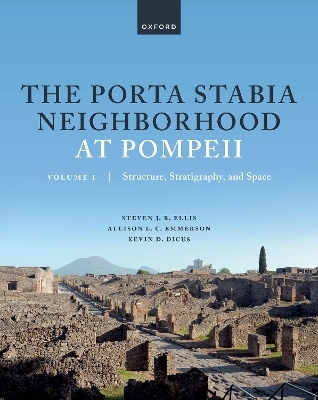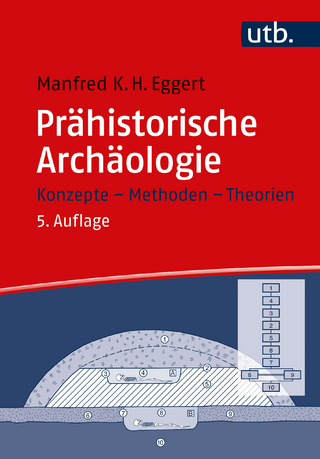
The Porta Stabia Neighborhood at Pompeii Volume I
Oxford University Press (Verlag)
978-0-19-286694-3 (ISBN)
This is the first of four volumes that present the results from the University of Cincinnati's archaeological excavations of the Porta Stabia neighborhood at Pompeii. These excavations targeted two town blocks on either side of the via Stabiana (insulae VIII.7 and I.1), which comprised modest houses, shops, workshops, food and drink outlets, and hospitality buildings.
The present volume describes and documents the phased, structural development of this neighborhood over several centuries. The earliest discernible activity here dates to the 6th century BCE, with the insulae taking their definitive shape only in the 2nd century BCE. It is from this time that production activities dominate the neighborhood, only to be wholly replaced by retail-oriented street-fronts from the early 1st century CE. Underpinning this narrative of urban development is a focus on the social and structural making of the Porta Stabia neighborhood, along with an interest in both the micro- (urban site formation processes) and macro-contextualization of the site (setting the results within a larger historic and urban framework).
Steven J. R. Ellis is a Roman archaeologist with interests in ancient cities and urban life. He has directed the University of Cincinnati's excavations at both Pompeii (the 'Pompeii Archaeological Research Project: Porta Stabia') and Sardinia (the 'Tharros Archaeological Research Project'), and co-directed an urban survey at Isthmia, Greece. His previous books include The Roman Retail Revolution (Oxford 2018) and the edited volume The Making of Pompeii: studies in the history and urban development of an ancient city (Portsmouth RI 2011). He is Associate Professor of Classics at the University of Cincinnati. Allison L. C. Emmerson is a Roman archaeologist with particular interest in the margins of Roman cities - not only their physical edges and the distinct cultural and economic activities they attracted, but also the lives of residents marginalised both in antiquity and in modern scholarship. Her first book, Life and Death in the Roman Suburb (OUP 2020) was awarded the Archaeological Institute of America's Wiseman Book Award in 2022 . She is director of the Pompeii I.14 Project and Associate Professor in the Department of Classical Studies at Tulane University. Kevin D. Dicus received his PhD from the Interdepartmental Program of Classical Art and Archaeology at the University of Michigan (2011). His is associate professor of Classics at the University of Oregon, teaching the archaeology of the ancient Mediterranean world as well as Latin and literature courses. His primary interest is the archaeology of Italy during the mid- to late-Republican period. Other interests include material culture theory, formation processes in the archaeological record, the sacred landscape of the Tolfa Mountains north of Rome, and waste management strategies in ancient urban settings.
Steven J. R. Ellis: Preface and Acknowledgements
Abbreviations
List of tables
List of Figures
I
1: Steven J. R. Ellis: Introduction
2: Steven J. R. Ellis: Methodology
3: Christopher F. Motz & John Wallrodt: The Database
4: Ambra Spinelli & Aimeé Scorziello: The History of Excavation and Research Activity in VIII.7 and I.1
5: Gregory Tucker: A Ground Penetrating Radar (GPR) Survey of Insulae VIII.7 and I.1 in Pompeii
6: Eric E. Poehler: The Architecture of the Porta Stabia Neighborhood: Method, Design, and Construction
7: Mark Robinson: The Geomorphology and Topography of the Area of the Porta Stabia Excavations (Pompeii VIII.7 and I.1)
II
8: Phase 1, The Earliest Structures and Surfaces (Sixth - Third centuries BCE)
9: Phase 2, The Beginning of Production Activity (Third - Second Centuries BCE)
10: Phase 3, The Establishment of Insulae VIII.7 and I.1 (c. 125 - c. 80 BCE)
11: Phase 4, Fish-Salting and Other Activities across Insulae VIII.7 and I.1 (Early First Century BCE - Early First Century CE)
12: Phase 5, The Rise of Retail in the Early Imperial Period (Early First Century CE)
13: Phase 6, The Julio-Claudian Years (Mid First Century CE)
14: Phase 7, The Final Years Following the Earthquake/s (Early 60s - 79 CE)
15: The Properties through the Phases
III
16: Ivo van der Graaff: The Porta Stabia Gate and Fortification
17: Allison L. C. Emmerson: The Porta Stabia Necropolis
18: Steven J. R. Ellis, Allison L. C. Emmerson & Kevin Dicus: Conclusions
IV
19: Appendices
19.1: Sarah Wenner: The Bar counters of Insulae VIII.7 and I.1, Pompeii
19.2: Christopher F. Motz: The Cisterns of Insulae VIII.7 and I.1, Pompeii
19.3: Jenny R. Kreiger: The Cooking Facilities of Insulae VIII.7 and I.1
19.4: Steven J. R. Ellis: The Doorstops of Insulae VIII.7 and I.1
19.5: Christopher F. Motz: The Drains of Insuale VIII.7 and I.1
19.6: Christopher F. Motz: The Fish-Salting Vats of Insulae VIII.7 and I.1
19.7: Jenny R. Kreiger: The Floors of Insulae VIII.7 and I.1
19.8: Eric E. Poehler: The Quarry Areas of Insulae VIII.7 and I.1
19.9: Jenny R. Kreiger & Ambra Spinelli: The Ritual Contexts in Insulae VIII.7 and I.1
19.10: Catherine Baker: The Soak-aways of Insulae VIII.7 and I.1
19.11: Steven J. R. Ellis: The Thresholds of Insulae VIII.7 and I.1
19.12: Kevin Dicus: The Votive Objects of Insulae VIII.7 and I.1
19.13: Kevin Dicus: The Toilets and Cesspits of Insulae VIII.7 and I.1
19.14: Jacqueline DiBiasie-Sammons: The Graffiti and Dipinti of Insulae VIII.7 and I.1
20: The Contexts
21: The Harris Matrices
Bibliography
Index
| Erscheinungsdatum | 08.08.2023 |
|---|---|
| Zusatzinfo | 375 |
| Verlagsort | Oxford |
| Sprache | englisch |
| Maße | 225 x 287 mm |
| Gewicht | 2362 g |
| Themenwelt | Geisteswissenschaften ► Archäologie |
| Geschichte ► Allgemeine Geschichte ► Vor- und Frühgeschichte | |
| Geschichte ► Allgemeine Geschichte ► Altertum / Antike | |
| Geisteswissenschaften ► Geschichte ► Regional- / Ländergeschichte | |
| ISBN-10 | 0-19-286694-X / 019286694X |
| ISBN-13 | 978-0-19-286694-3 / 9780192866943 |
| Zustand | Neuware |
| Haben Sie eine Frage zum Produkt? |
aus dem Bereich


